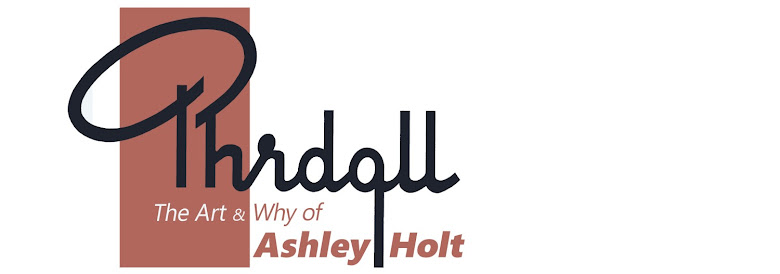Sure, sometimes the likenesses on my portraits are way off. Try as I might to capture the essence of a particular face, it can happen that an attempted Martin Sheen can look too much like Esther Williams. Caricature is difficult stuff, people. Negotiating the proportions of facial features can seem like trying to defuse a time bomb - the face can seem burned beyond recognition in an instant.
And this is why I ask you to be considerate of this delicate challenge. Don't judge me by the standards of a celebrity likeness. This task is too tenuous, precarious. Instead, judge me by the craftsmanship I apply to my true art: The design of men's sleeve folds.
The shadowy shapes of Joseph Cotten's sleeve seem to point in different directions at once. Could this be intended to suggest the conflicted nature of Cotten's character in Portrait of Jennie? Or is there some message in this conflict for all of us to recognize - the turmoil of the modern human condition, fracturing our child-like notions of free will and personal destiny? The moral tableau embedded in these gray creases presents a cautionary tale for the ages.
Obviously, I pride myself on my design of men's jacket folds. Of course the Philistines of our modern illustration business are not sophisticated enough to accept this as the true focus of my art. So I continue the cheap parlor trick of celebrity likeness, assured that those who care to scrutinize my efforts will see I have something extra up my sleeve.
And this is why I ask you to be considerate of this delicate challenge. Don't judge me by the standards of a celebrity likeness. This task is too tenuous, precarious. Instead, judge me by the craftsmanship I apply to my true art: The design of men's sleeve folds.
I often put twice as much time into the design of men's sleeve folds as I do on the same guy's face. And frankly, I think all artists should be judged by their sleeve folds, so I'm willing to put my own efforts up to public scrutiny by the same criteria. The Summer Under the Stars series gave me plenty of opportunity to deal with sleeve folds. Not all of them were successful, of course. Edmond O'Brien's sleeve above is certainly nothing to write home about.
But how about Herbert Marshall here? I'd suggest this elegant gray and white design compliments the quiet dynamics of a Marshall performance, don't you? It's bold without being arrogant - crisp, yet full of tension. This is a sleeve which can haunt your memory.
If I do say so myself, Cary Grant's sleeve is near perfection. It's the right combination of line and shape, balanced and neatly contained. The jaunty interplay of light and shadow mirrors the vibrant, whimsical performance of Grant himself. If this sleeve could talk, it would say, "Judy, Judy, Judy," for the sleeve expresses what Cary himself never actually did.
The shadowy shapes of Joseph Cotten's sleeve seem to point in different directions at once. Could this be intended to suggest the conflicted nature of Cotten's character in Portrait of Jennie? Or is there some message in this conflict for all of us to recognize - the turmoil of the modern human condition, fracturing our child-like notions of free will and personal destiny? The moral tableau embedded in these gray creases presents a cautionary tale for the ages.
The utilitarian quality of David Niven's sleeve is regal, yet somehow slovenly. "Wait," the sleeve seems to say. "Let us not rush into the rise and fall of an elbow crease as if working a bicycle pump. Ours is an objective of style, even as we flex and bend our way through life's ordeals." Niven's sleeve has a quiet strength - the noble savage of tailored fashions. It would win an arm wrestling match simply by virtue of its game face. It goes without saying that this is dry clean only.
My personal standard for men's sleeve folds was set several years ago by this notable Jack Webb sleeve. It is my personal best - my high score in Space Invaders, my championship wheelbarrow race trophy. This one lasts the test of time as an expression of sleeveness itself - a brutal distillation of a lifetime of fabric tension. To ask if this is linen or gaberdine is to miss the larger point. This sleeve is woven of the human experience, on a loom of brotherhood, in a sweatshop of name-brand universal consciousness. Follow the path set by this sleeve and the dynamic tension of our daily wear will never create undue stress. Jack would have wanted it that way.
Obviously, I pride myself on my design of men's jacket folds. Of course the Philistines of our modern illustration business are not sophisticated enough to accept this as the true focus of my art. So I continue the cheap parlor trick of celebrity likeness, assured that those who care to scrutinize my efforts will see I have something extra up my sleeve.







No comments:
Post a Comment